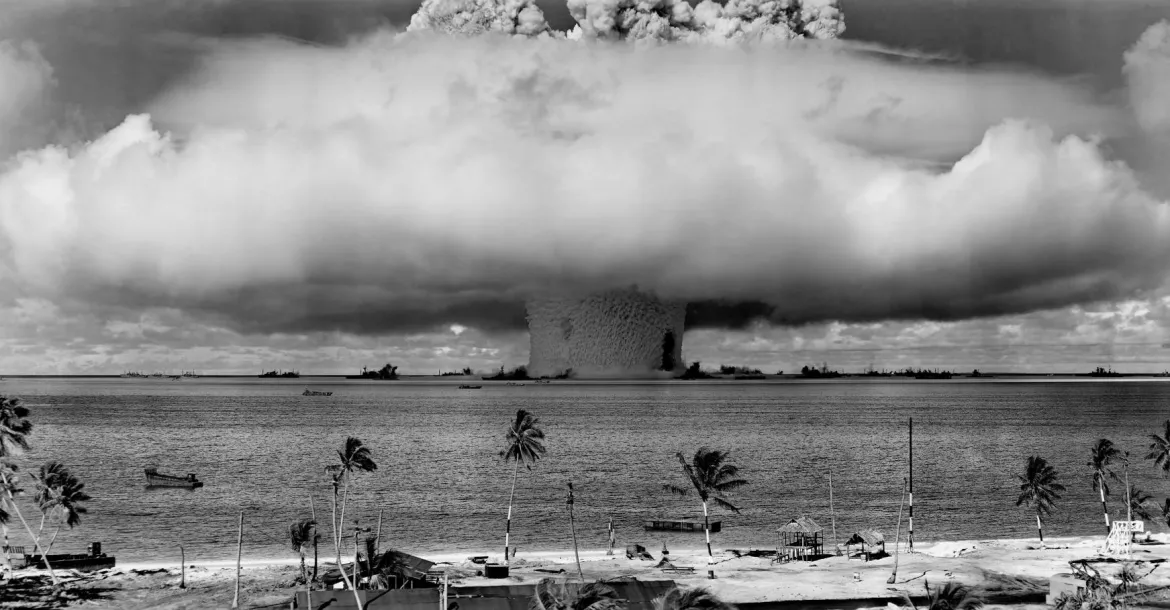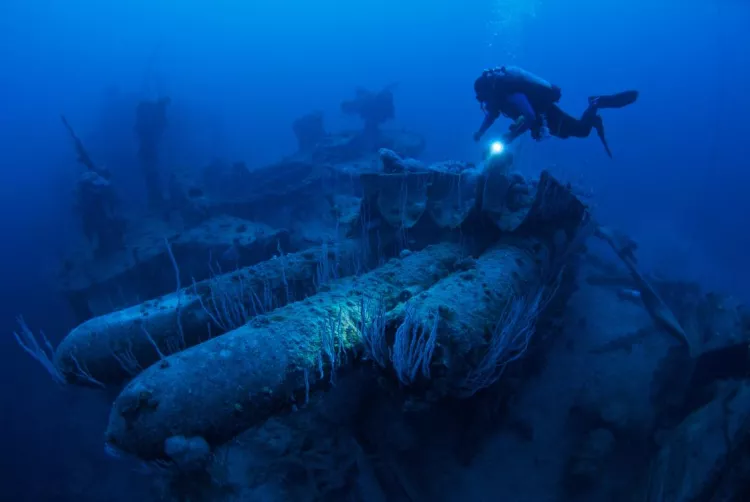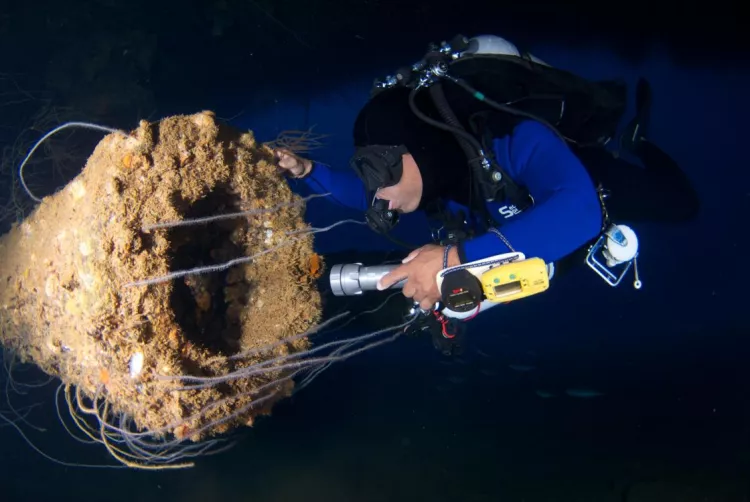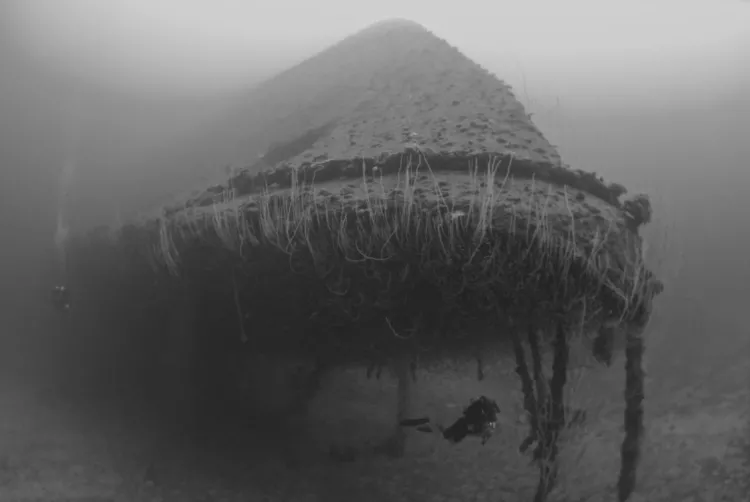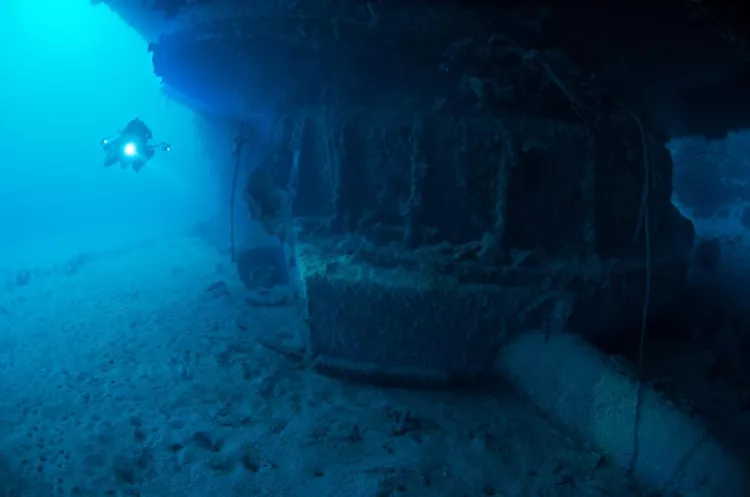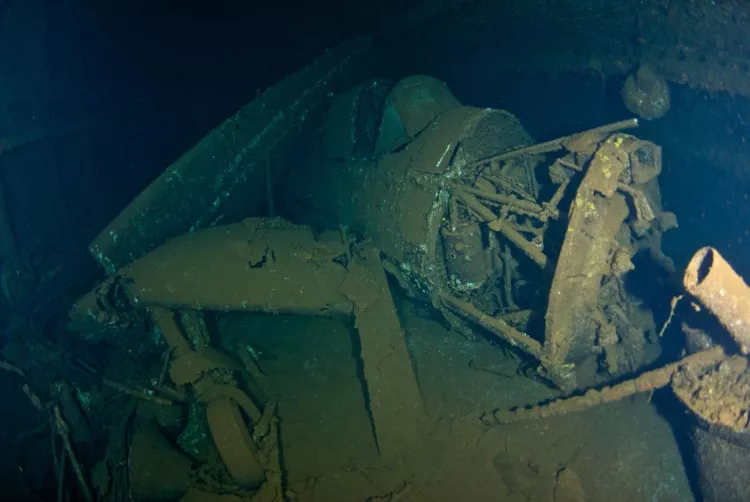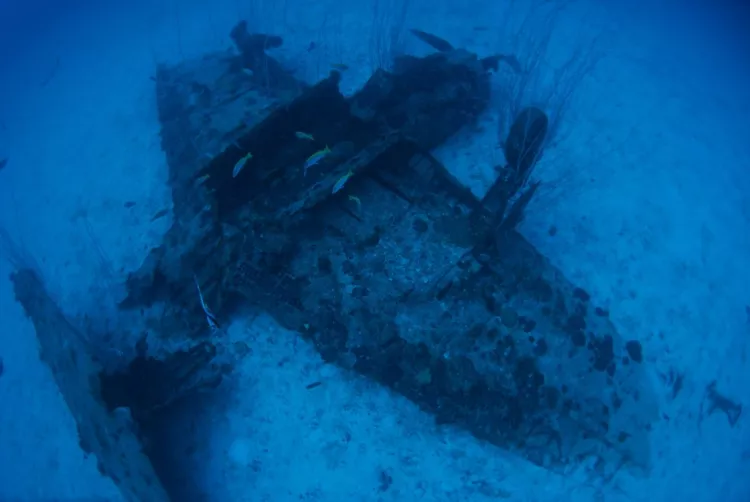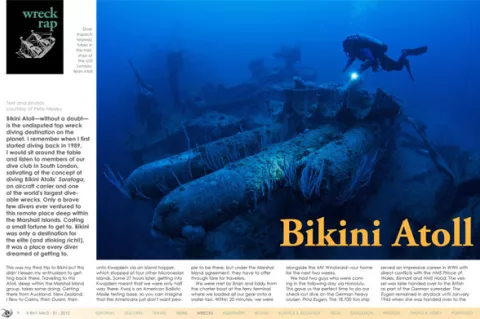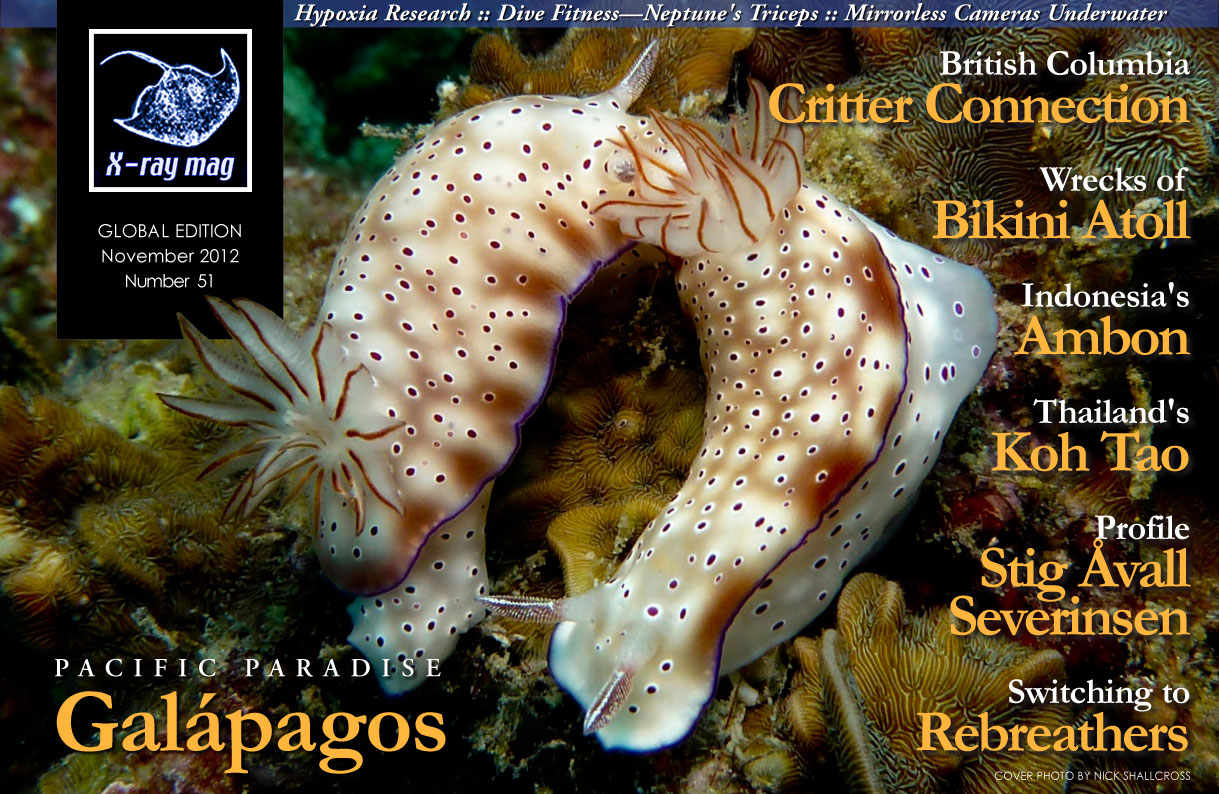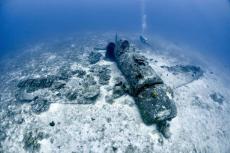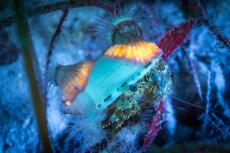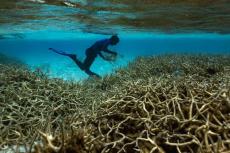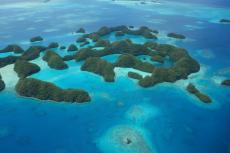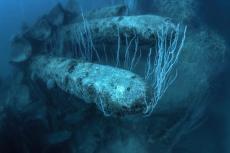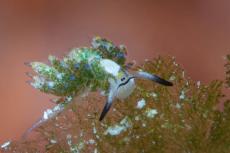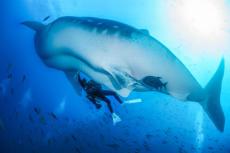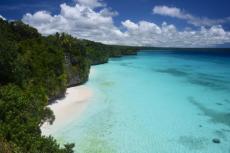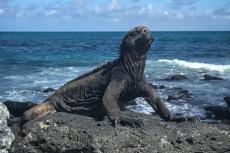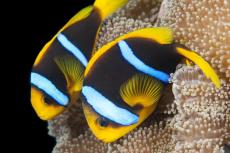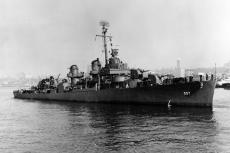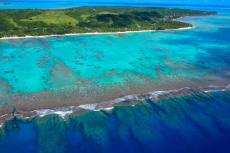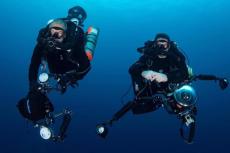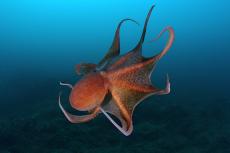Bikini Atoll—without a doubt—is the undisputed top wreck diving destination on the planet. I remember when I first started diving back in 1989, I would sit around the table and listen to members of our dive club in South London, salivating at the concept of diving Bikini Atolls’ Saratoga, an aircraft carrier and one of the world's largest diveable wrecks. Only a brave few divers ever ventured to this remote place deep within the Marshall Islands. Costing a small fortune to get to, Bikini was only a destination for the elite (and stinking rich!!). It was a place every diver dreamed of getting to.
Contributed by
Factfile
Pete Mesley is a prolific wreck diver and seasoned photographer, who organizes specialized trips to some of the most spectacular and out-of-the-way locations, globally. His excursions offer full technical support for rebreather and open circuit divers.
Not to mention, he is one of the only dive operators who brings qualified hyperbaric physicians with him as medical support on all of his trips. For more information about his “Lust for Rust” diving excursions visit his website: lust4rust.com.
This was my third trip to Bikini but this didn’t lessen my enthusiasm to getting back there. Traveling to this Atoll, deep within the Marshal Island group, takes some doing. Getting there from Auckland, New Zealand, I flew to Cairns, then Guam, then onto Kwajalein via an island hopper, which stopped at four other Micronesian islands. Some 27 hours later, getting into Kwajalein meant that we were only half way there. Kwaj is an American Ballistic Missile testing base, so you can imagine that the Americans just don't want people to be there, but under the Marshal Island agreement, they have to offer through fare for travelers.
We were met by Brian and Eddy from the charter boat at the ferry terminal where we loaded all our gear onto a water taxi. Within 20 minutes, we were alongside the MV Windward—our home for the next two weeks.
We had two guys who were coming in the following day via Honolulu. This gave us the perfect time to do our check-out dive on the German heavy cruiser, Prinz Eugen. The 18,700 ton ship served an impressive career in WWII with direct conflicts with the HMS Prince of Wales, Bismark and HMS Hood. The vessel was later handed over to the British as part of the German surrender. The Eugen remained in drydock until January 1946 when she was handed over to the Americans. Later, she was allocated to the target fleet for Operation Crossroads. She survived the Able and Baker tests (July 1946), but was too radioactive to have leaks repaired. In September 1946, she was towed to Kwajalein Atoll and capsized on 22 December 1946 over Enubuj reef.
This massive 212-meter wreck sits upside down in 32 meters of water, stern sitting out of the water with the bow at the deepest section. What an impressive introduction to the trip!
Once everyone was on board, we stropped everything down and set sail for Bikini. It took us a little over 28 hours steaming to cover the 240 miles to our destination. On the way, we sailed past Wotho Atoll. This was a short distance away from Rongerik Atoll. This is where the Americans relocated the entire population of 167 Bikinians in March 1946, in preparation for Operation Crossroads.
Rongerik was originally uninhabited because the Bikinians believed it to be too small to live on (it is one sixth the size of Bikini), and there wasn't enough food and water on the island to sustain life.
Well, they were right. By July that same year, medical officers from the United States visited the islands. They were shocked to find that the people were critically malnourished and literally starving to death. Immediate preparations were made to transfer them 300 miles west off Bikini to an atoll known as Ujelang.
It just so happened that the Americans chose another nuclear testing ground in Enewetak Atoll, 120 miles north east of Ujelang. Even after all the buildings were erected for the Bikinians to move into on Ujelang Atoll, it was decided that the Enewetak people would, instead, be moved to Ujelang Atoll. It took two years of suffering on Rongerik until the Bikinians were finally moved to Kwajalein. They were housed in tents beside an airstrip until an island was finally found for them to live on.
Diving the wrecks
We arrived in Bikini in the late afternoon the next day. On the way, we dragged a couple of lures over the side. On the last attempt, I got a massive dogtooth tuna. This time, I ended up hooking a 100kg black marlin.
It was taking over an hour and a half to get the fish close to the boat, so we decided to release it once we could get it close enough to unhook it. But just as we got the massive fish close to the stern of the boat, a shark promptly removed the tail section of the fish.
Bugger! We didn't have much choice then but to eat it. This is what it's all about with expeditions like this to far corners of the Earth. Just being here, sitting in 4,000 meters of water with no sight of land anywhere to be seen—I just loved it!
HIJMS Nagato. The first dive was on the HIJMS Nagato. Launched on 9 November 1919, the Nagato was the jewel of the Imperial Japanese Navy. She was the lead ship of her class and the only battleship in history to mount 16.1-inch guns on her decks. She displaced 42,850 tons, and was 221m long, 34m wide and capable of doing 27 knots.
Descending onto this historical ship was very humbling. Knowing that this was the ship that Admiral Isoroku Yamamoto gave the order to lead the attack on Pearl Harbor back in December 1941 made history more tangable. We got our first sight of the ship with its huge hull and four props as we descended into the crystal clear water. We dropped over the port side of the ship and under the hull. There, looming out of the darkness, were two massive 16.1-inch guns. My dive buddy, Nick, swam up towards the barrel ends. His body was dwarfed by its massive size.
We came back out and swam along the port side of the hull at deck level at a constant 45m depth. Then, as we swam along, the bridge came into view. What used to tower above the surface of the ocean, some 30m high, now sits perfectly placed along the sand to one side of the ship. I swam forward towards the bow section, turned around and just hung there in the deep enjoying the view of the entire bridge section.
Penetration is possible but extreme care must be taken. All the wrecks are over 60 years old and very brittle, so with all the heavy gear above your head, you tend to take care when venturing down passageways. The areas that we penetrated were not as spectacular as the vistas around the outside of the ship—a massive propeller, breathtaking bridge section and impressive bow section.
USS Saratoga. The majority of our afternoon dives were spent on the USS Saratoga. She is the shallowest of the ships in the atoll. The top of the bridge ranged in depth from 14m of water down to 50m on the sand.
The Saratoga, first commissioned in 1925, was a 40,000-ton, 268-meter-long aircraft carrier. She did tours in the Pacific, Nicaragua, San Diego, Hawaii, Guadalcanal and the Marshall Islands.
In 1944, she was commissioned to train aviators for night operations. In February 1945, she carried night fighters during the Iwo Jima invasion and raids on the Japanese home islands. After the war in 1945, she transported servicemen back home to the States, was then decommissioned and brought in for target duty for atomic testing in Bikini.
The interior of the ship is vast, to say the very least. Permanent lines have been laid in some areas from a past operation and still hold well after six years of inactivity. With seven decks of passageways, rooms, storerooms, accommodations, galleys, etc, you could spend the rest of your diving career on this ship and never grow tired if diving her.
One of the dives that totally blew my mind was the dentist's surgery and sick bay. We entered through the bomb loading door situated on the starboard side of the ship just forward of the bridge area, dropped two decks into the middle section, swam 50 meters down long corridors, then dropped down a staircase into the second and hangar decks. We then back tracked and swam another 15 odd meters, passing the sick bay on our right. Then, finally, we entered the dental office.
Three dentist chairs sat in the room, completely kitted out with drills, rinse bowls, even head phones for the patients. Perfectly preserved. Everything was covered in the finest red rusty silt, probably highly radioactive if you dug deep enough into it.
The wreck is just so impressive. Countless planes, bombs, artifacts, plates, bowls, jugs, etc, lay untouched since 1946. Even Mk 5 standard dress helmets sit alongside each other in one of the hundreds of store rooms in the ship.
Saratoga, along with another 20 odd other ships, sank as a result of nuclear testing after the abrupt end of the Second World War, with the United States dropping atomic bombs on Hiroshima (6 August 1945) and then on Nagasaki three days later. These were the second and third atomic bombs ever detonated on Earth. So little was known about atomic warfare.
Atomic history
The US president at the time, Harry Truman, issued a directive to army and navy officials that joint testing of nuclear weapons would be necessary “to determine the effect of atomic bombs on American warships”. This project was to be held in Bikini Atoll named Operation Crossroads. Two hundred forty-two ships (150 support and 95 detonation ships), 42 thousand men, 156 airplanes and hundreds of thousands of tons of equipment, ordinance and materials were shipped to Bikini Atoll.
This was to be the most public and most reported nuclear tests ever undertaken. Even though there was considerable interest by scientists excited about assessing the full effects of atomic energy in the field, it was still undertaken for the sole benefit of the military. Their main goal: to make stronger, deadlier nuclear weapons.
Ninety-five ships were to be prepared for the blast, four battle ships, two aircraft carriers, two cruisers, 11 destroyers, eight submarines, numerous amphibious/auxiliary vessels and three surrendered German and Japanese vessels. Twenty ships would be placed in square mile clusters from the drop zone.
The initial 23 kiloton bomb, named Able, was to be detonated 158 meters above sea level. This test was to asses the effects of pressure, impulse, shock wave, velocity, optical radiation and nuclear radiation of this particular bomb. This air burst was meant to duplicate the conditions of the Hiroshima bomb drop, this time, over water. With an air burst, the radioactive matter would rise high into the stratosphere and become part of the global environment with little significant local fallout. Many of the closer ships received doses of neutron and gamma radiation, lethal to anyone onboard the ship during the blast, but the ships themselves did not become radioactive.
Within a day, all the surviving target ships had been re-boarded by personnel for inspection and data analysis. Able sank five ships, Gilliam, Sakawa, Carlisle, Anderson and Lamson.
The second explosion, Baker bomb, was detonated 24 days later on 25 July 1946. This bomb was suspended 27 meters underwater. The underwater fireball took the form of a rapidly expanding hot “gas bubble” that pushed against the water, generating a supersonic hydraulic shock wave, which crushed the hulls of nearby ships as it spread out. On the surface, the shock wave was visible as the leading edge of a rapidly expanding ring of dark water. Close behind the slick was a visually more dramatic, whitening of the water surface.
At the bottom, it started digging a shallow crater, 9m deep and 610m wide. At the top, it pushed the water above it into a “spray dome”, which burst through the surface like a geyser.
During the first full second, the expanding bubble removed all the water within a 150m radius and lifted two million tons of spray and seabed sand into the air. As the bubble rose, it stretched the spray dome into a hollow cylinder or chimney of spray 1,800m high, 610m wide, and with walls 90m thick.
As soon as the bubble reached the air, it started a supersonic atmospheric shock wave, which, like the crack, was more visually dramatic than destructive. Brief low pressure behind the shock wave caused instant fog, which shrouded the developing column in a “condensation cloud”, obscuring it from view for two seconds. The Wilson cloud started out hemispherical, expanded into a disk, which lifted from the water revealing the fully developed spray column, then expanded into a doughnut and vanished. The Able shot also produced a Wilson cloud, but heat from the fireball dried it out more quickly.
Ten ships were sunk as a result of Baker bomb. They were LSM-60 (the ship that the bomb was positioned under), Arkansas, Pilotfish, Saratoga, YO-160, Nagato, Skipjack, Apogon, ARDC-13.
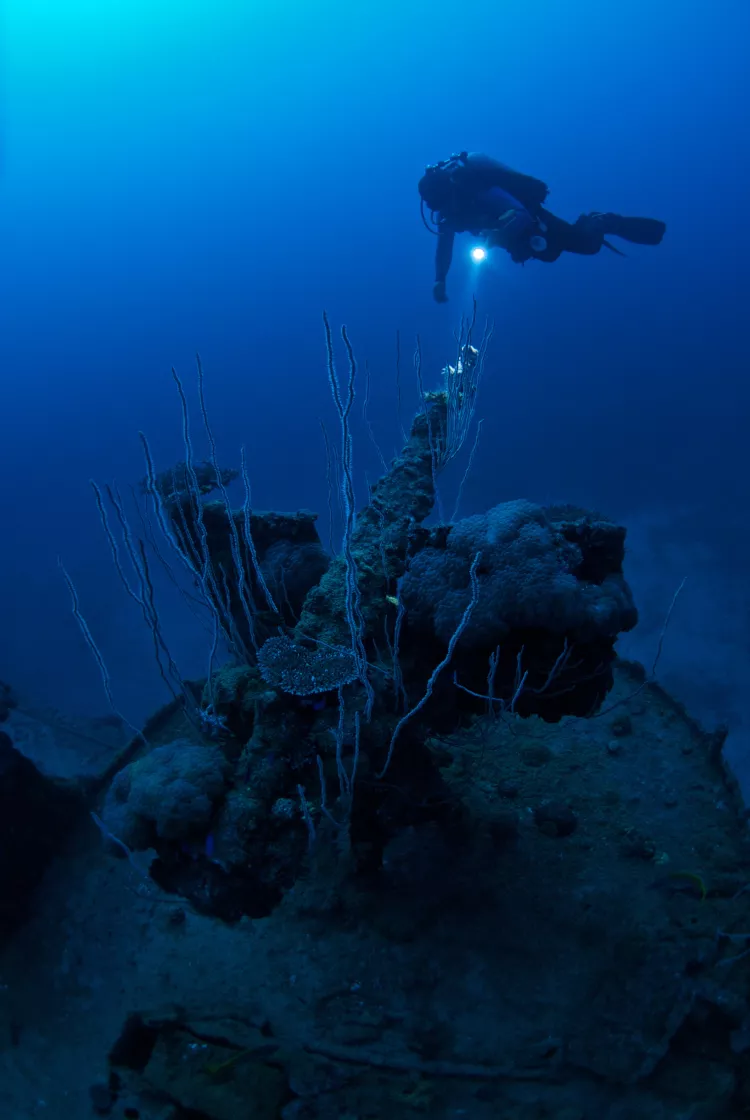
USS Lamson. Another outstanding wreck that we dived was the USS Lamson. A 1,500-ton, 104m-long Mahan Class destroyer, first launched on 17 June 1936. The Lamson did tours in the Caribbean, Pacific and Hawaii.
On that ill-fated day on 7 December 1941 when Pearl Harbour was attacked, the USS Lamson was returning from patrol duty out at sea during the Japanese attack. After an unsuccessful search for the Japanese task force, the destroyer patrolled Hawaiian waters, departing Pearl Harbor on 6 January 1942, later heading to Guadalcanal, moving onto doing tours in Papua New Guinea, New Britain and the Philippines. After fighting off numerous suicide plane attacks and being patched up after being badly damaged, she spent the rest of her term on patrol and air-sea rescue work off Iwo Jima Island. She would soon participate in Operation Crossroads in Bikini.
With consistently good visibility in the Lagoon, the Lamson could be seen as we descended down the shotline. Secured in the midships, I made my way down towards the stern of the ship. First landmarks that burst out into view were the amazing 21-inch torpedo tubes. The ship had a total of 12 torpedo tubes on the deck of the ship. Moving on, I came across two Oerilikon 20mm AA antiaircraft guns, mounted on each side of the narrow destroyer. It was easy to see that in this ships heyday it could hold its own with all the armament it carried.
Heading further towards the stern I swam past two 5-inch/38 Cal dual purpose antiaircraft guns. Their dual purpose allowed them to shoot not only low angle, surface targets but also high angle aircraft targets.
I finally got to the stern of the ship—she was an awesome sight alright. The depth charge racks were still fully intact with even a few depth charges still laying on the deck. The wreck was silhouetted perfectly against the talcum powder-like white sand.
Over the following days, we made numerous dives on the Saratoga and Nagato, Anderson, Arkansas and Sakawa. We also dived a submarine, one of the three sunk during the blasts, the USS Apogon—a 95m-long, 2,390-ton, Balao-Class submarine first launched in March 1943. She sits perfectly upright on a lifeless sandy bottom. Not a lot of life is encrusted on the wrecks, just long sea whips and tight sponges, which give the wrecks a little colour. Here, my dive buddy, Eddy, looked at one of the stern torpedo tubes with a loaded torpedo in the spout.
Afterthoughts
Bikini Atoll, was everything I ever dreamed of and more. But the wrecks are starting to show their age. More and more parts of the ships are collapsing, so if you want to see these wrecks in all their glory, I suggest you start planning your journey here in the near future. During the trip, we completed over 38 hours in the water over nine days, diving seven of the 16 odd wrecks in the lagoon. A place certainly worthy of multiple trips. ■

